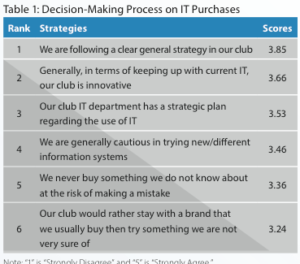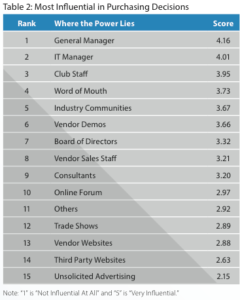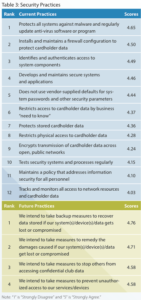In 2011, the National Club Association (NCA) and Hospitality Financial and Technology Professionals (HFTP®) established the NCA-HFTP Technology Task Force to assess the landscape of technology in clubs. In that study, electronic communication (such as club websites, email, social-networking and text messaging) was identified as a critical area on which clubs expressed interest in obtaining more information and guidance. Club software was also noted as another important area. The findings were published in the 2011 fall issues of Club Director and The Bottomline.
Fast-forward six years to a new study that investigates club technology based on a random sample of 1,590 clubs. The purpose of this survey was an exploration of technology use in clubs, systems use and satisfaction, and more. This article concentrates on two areas of the study:
- Information technology (IT) purchases decision criteria and decision makers
- How clubs are managing the security of their systems
HFTP sent an online survey to clubs in mid-January 2017 and obtained data from 141 respondents in 21 states, and seven respondents from outside the U.S. The three states that had the most clubs reply were Florida (17%), New York (11%) and California (7%). The majority of the clubs were country and golf clubs (56%), city/athletic clubs (16%) and gated community country clubs (14%). In addition, most clubs had membership between 301–650 members (47%). These respondents who participated in the study on behalf of their clubs included controllers, CFOs, directors of IT, IT managers and assistant controllers.
Decision Making
 The Process
The Process
Every IT purchase is a major decision and should be done thoughtfully. As seen in Table 1, some clubs have a clear general
strategy regarding purchasing (scoring 3.85 out of 5, where 5 means “Strongly Agree”) and others have strategic plans specifically designed for IT (3.53). Yet, it can be said that clubs adopt a slightly conservative stance as they are generally cautious in trying new systems (3.46) and would rather stay with a vendor they usually buy from rather than trying something new and unknown (3.24).
The Influencers

 As for who holds the “purse strings” in IT purchasing (Table 2), the general manager (4.16 out of 5, where 5 means “Strongly Influential”) and the club IT manager (4.01) both have influential scores of 4 or higher. Four other factors have scores higher
As for who holds the “purse strings” in IT purchasing (Table 2), the general manager (4.16 out of 5, where 5 means “Strongly Influential”) and the club IT manager (4.01) both have influential scores of 4 or higher. Four other factors have scores higher
than 3.50: club staff, word of mouth, industry communities and vendor demonstrations. While trade shows, vendor websites, third party websites and unsolicited advertising might not be most influential in the purchasing decisions, these are undoubtedly some of the best venues to research and gather information about the many systems in the market.
Security Practices
One of the very positive results of this study is the understanding that clubs addressed the subject of cyber security seriously. Indeed, cyber hackers have been busy, targeting hotels of all sizes and on various continents. Clubs store very sensitive and confidential information about their members and the cyber attacks represent a real threat, so much so that clubs can purchase liability insurance against cyber attacks (see “What is Cyber Liability Insurance?”).
 Current Practices
Current Practices
 When a list of 12 security practices was given to the clubs to rate (Table 3), all 12 practices received scores higher than 4 out of a possible score of 5 (where 5 means “Strongly Agree”). The one practice that most clubs agree on was to protect all systems against malware and regularly update anti-virus software or program (4.65). With the use of credit cards to settle charges or even monthly billing, installing and maintaining firewall configurations to protect cardholder data was ranked second (4.50), followed closely by identifying and authenticating access to system components (4.49). Indeed, club management understands the seriousness of a cyber attack. Together with PCI compliance, clubs are well aware of the negative consequences of cyber attacks and are protecting their data.
When a list of 12 security practices was given to the clubs to rate (Table 3), all 12 practices received scores higher than 4 out of a possible score of 5 (where 5 means “Strongly Agree”). The one practice that most clubs agree on was to protect all systems against malware and regularly update anti-virus software or program (4.65). With the use of credit cards to settle charges or even monthly billing, installing and maintaining firewall configurations to protect cardholder data was ranked second (4.50), followed closely by identifying and authenticating access to system components (4.49). Indeed, club management understands the seriousness of a cyber attack. Together with PCI compliance, clubs are well aware of the negative consequences of cyber attacks and are protecting their data.
Future Practices
In terms of future practices, clubs also intend to take measures to recover data, remedy damages, stop unauthorized parties from accessing confidential club data, and prevent such parties from accessing the services and devices of the club. All these four practices received very high ratings, above 4.58 out of 5.
To Technology and Beyond
One respondent best summed up the present and future of IT in clubs when she shared what she terms as the two “roadblocks” within the club industry. First, technology is an expensive proposition. Faced with limited budgets and yet a never-ending list of new systems and gadgets, if a club postpones an update or installation, its technology will simply fall behind. As an industry, clubs value personal service to their members to the extent to which they view technology as an intrusion. Certain clubs still ban cell phones in their dining rooms. However, hotels and restaurants use technology extensively from marketing to in-house upselling, ordering for services and products, and even payment. Therefore, besides falling behind in IT as an individual club, the industry itself can also fall behind relative to other hospitality industries.
Second, not only are club personnel multi-generational, club members also span many generations. From a workforce and management standpoint, while the younger workforce is more tech savvy and embraces IT use, the more seasoned colleagues might deny technology upgrade requests, viewing them as “unnecessary.” Sometimes, these decisions might come from a board whose members are more resistant to technology changes and still prefer hard copies of all documents. If such practices persist, the club industry will fall behind as technology evolves. Furthermore, employees with more foresight may see the club industry as a deterrent to their career growth and may simply move to other hospitality industries such as hotels, restaurants, cruise ships, or even join the vendor side of the business. A loss of human talent is surely not desirable.
From the members’ standpoint, using the cellphone ban example, if mobile phones are banned in the dining room or by the pool, the younger generation who like to snap pictures and post them to social media would not enjoy the club experience as much when coming to the club with their “older” family members. They may opt to dine at a restaurant instead, and the food and beverage revenues of clubs may suffer.
While best practices recommend careful use of club social media channels, members post images of their activities at the club to their own social media accounts—illustrating to friends and family positive experiences like the club’s Mother’s Day Brunch or July 4th celebrations. However, restricted use of cell phones to capture these events hinders sharing of fantastic club activities. Clubs could find ways to create a perfect blend of legacy and contemporary club experiences that wow all members and guests. Technology is only going forward. So should we.
References:
Venegas, T., Howton, J., & Abrams, J. (2011). Club technology resource needs: What clubs want to know. Club Director, Fall 2011 and The Bottomline, 26(6), 10–16.
Agnes DeFranco, Ed.D., CHAE is a distinguished chair and professor at the Conrad N. Hilton College of Hotel & Restaurant Management, University of Houston. She can be reached at aldefranco@central.uh.edu. Cristian Morosan, Ph.D., is an associate professor at the Conrad N. Hilton College of Hotel & Restaurant Management, University of Houston. He can be reached at cmorosan@uh.edu. This article is based on a study commissioned by Hospitality Financial and Technology Professionals (HFTP); learn more about the association at hftp.org.


